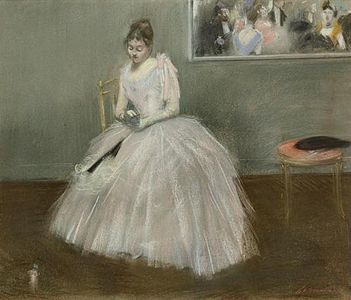Jean-Louis Forain
This articleneeds additional citations forverification.(June 2013) |
Jean-Louis Forain | |
|---|---|
 Jean-Louis Forain drawing in his studio | |
| Born | Louis Henri Forain 23 October 1852 Reims,France |
| Died | 11 July 1931(aged 78) Paris, France |
| Spouse | Jeanne Bosc |
| Elected | Royal Academy of Arts |

Jean-Louis Forain(23 October 1852 – 11 July 1931) was a FrenchImpressionistpainter andprintmaker,working in media including oils,watercolour,pastel,etchingandlithograph.Compared to many of his Impressionist colleagues, he was more successful during his lifetime, but his reputation is now much less exalted.
Life and work
[edit]Forain was born inReims,Marnebut at age eight, his family moved toParis.He began his career working as acaricaturistfor several Paris journals includingLe Monde ParisienandLe rire satirique.Wanting to expand his horizons, he enrolled at theÉcole des Beaux Arts,studying underJean-Léon Gérômeas well as another sculptor/painter,Jean-Baptiste Carpeaux.
Forain's quick and often biting wit allowed him to befriend poetsArthur RimbaudandPaul Verlaineas well as many writers, most notablyJoris-Karl Huysmans.He was one of only "seven known recipients" to receive a first edition ofA Season in Helldirectly from Rimbaud.[1]He was the youngest artist to frequent and participate in the feverish debates led byÉdouard ManetandEdgar Degasat theCafé de la Nouvelle Athènesin Montmartre.
A follower and protégé of Degas, Forain joined theImpressionistcircle in time to take part in the fourth independent exhibition in 1879; he participated in four of the eight Impressionist Exhibitions (1879, 1880, 1881 and 1886). Influenced by Impressionist theories on light and color, he depicted scenes of everyday life: his watercolors, pastels and paintings focused on Parisian popular entertainments and themes of modernity—the racetrack, the ballet, the comic opera and bustling cafés.
Forain was the most famous caricaturist of theBelle époque,and drew, among others, for theFigarofor more than 30 years. From 1898–1899 Forain worked as an illustrator for the weekly French magazinePsst...!,a satirical publication to promote the anti-Dreyfus.[2]
Aside from being influenced by his friend of over fifty years,Edgar Degas,Forain was greatly influenced byHonoré Daumier,and his treatment of subjects in his drawings for publications such asLe FigaroandLe Courrier Francaisare often reminiscent of Daumier's. In 1892 he published the first volume ofLa Comédie Parisienne,a collection of Forain's illustrations and commentary on the major political stories that disrupted France's Third Republic—such as the anarchic crisis and theDreyfus affair.In 1891 Forain married the painterJeanne Boscwith whom he had a son, Jean-Loup, born in 1895.
During the first World War, Forain's illustrations honored the patriotism of his contemporaries, and he enlisted in the Section de Camouflage underLucien-Victor Guirand de Scévola.In his later years, Forain created numerous scenes of the Law Courts and other Parisian institutions plus social satire caricatures of late 19th and early 20th century French life.
In 1931, shortly before his death, he was made a member of theRoyal Academy of ArtsinLondon.He was one of France's most famous and revered artists during his time. He was, perhaps, most highly respected for his numerous drawings which chronicled and commented on Parisian city life at the end of the 19th century. Followers and admirers of Forain's work includedHenri de Toulouse-Lautrec.
Nazi-looted art
[edit]On 22 January 2020 two works by Jean-Louis Forain that had been found in the Gurlitt stash in Munich, hidden by the son of one ofHitler's art dealer'sHildebrand Gurlitt,were restituted to the heirs of the Jewish art collectorArmand Dorville.[3][4][5]
Selected works
[edit]-
The Place Clichy,pastel,1883–1884
-
The Buffet,oil, 1884
-
The Prom Notebook,pastel,c 1888
-
Lower Box at the Theatre,etching, 1909
-
The Requisition,1919
-
Poster 51 inLes Maîtres de l'Affiche
-
Poster 186 inLes Maîtres de l'Affiche
References
[edit]- ^Robb (2000),p. 233: Rimbaud gave the others to his mother,Paul Verlaine,Ernest Delahaye,Raoul Ponchon,Jean Richepinand Ernest Millot.
- ^"Psst! - Anti-Semitic, Anti-Dreyfus Graphic Weekly - Paris, 1898–1899".Archived fromthe originalon 2 June 2021.Retrieved6 October2019.
- ^"Nouvelle restitution aux héritiers spoliés d'Armand Dorville".La Croix(in French). 25 March 2021.ISSN0242-6056.Archived fromthe originalon 25 March 2021.Retrieved13 June2021.
L'État allemand a été le premier, le 22 janvier 2020, à leur restituer deux œuvres de Jean-Louis Forain et un lavis de Constantin Guys, retrouvés dans la collection litigieuse de Cornelius Gurlitt.
- ^Chambers, Madeline (22 January 2020)."Germany returns Nazi art from Gurlitt trove to French family".Reuters.Retrieved13 June2021.
The two pictures from the Gurlitt collection were a watercolour entitled "Lady in an Evening Dress" and an oil painting "Portrait of a Lady" by Jean-Louis Forain. The third work, "Amazonian on Rearing Horse", was a drawing by Constantin Guys which had been in private ownership. All three had belonged to Dorville, who sought refuge at his estate in the Dordogne in unoccupied France in June 1940, where he died about a year later. Other members of his family perished at the Auschwitz death camp.
- ^"Less Than a Month After the Louvre Hired a Nazi Loot Expert to Investigate Its Collection, She Found 10 Ill-Gotten Works Hiding in Plain Sight".www.lootedart.com.Retrieved13 June2021.
Sources
[edit]- Jean-Louis Forain: The Impressionist Years.Exhibition Catalogue. Dixon Gallery and Gardens,1995.
- "Jean-Louis Forain: Artist, Realist, Humanist." International Exhibitions Foundation, Washington, D.C., 1982–1983.
- Robb, Graham(2000),Rimbaud,New York: W.W. Norton & Co,ISBN978-0330482820
- Charles Kunstler,Paris, F. Rieder & cie, 1931, 63p.contient 60 planches hors-texte en héliogravure.
- Florence Valdes-Forain, Memphis, Tennessee, U.S.A., The Dixon Gallery and Gardens, 2011ISBN9782759601554
External links
[edit]![]() Media related toJean-Louis Forainat Wikimedia Commons
Media related toJean-Louis Forainat Wikimedia Commons
- Jean-Louis Forain exhibition catalogs
- Metropolitan Museum of ArtDegas: The Artist's Mind,online exhibition catalog
- 1852 births
- 1931 deaths
- Artists from Reims
- 19th-century French painters
- French male painters
- French poster artists
- French portrait painters
- Religious painters
- 20th-century French painters
- 20th-century French male artists
- French caricaturists
- Impressionist artists
- French etchers
- French editorial cartoonists
- 19th-century French lithographers
- 20th-century French lithographers
- Members of the Académie des beaux-arts
- Camoufleurs
- Members of the Ligue de la patrie française
- 20th-century French printmakers
- Honorary Members of the Royal Academy
- 19th-century French male artists







